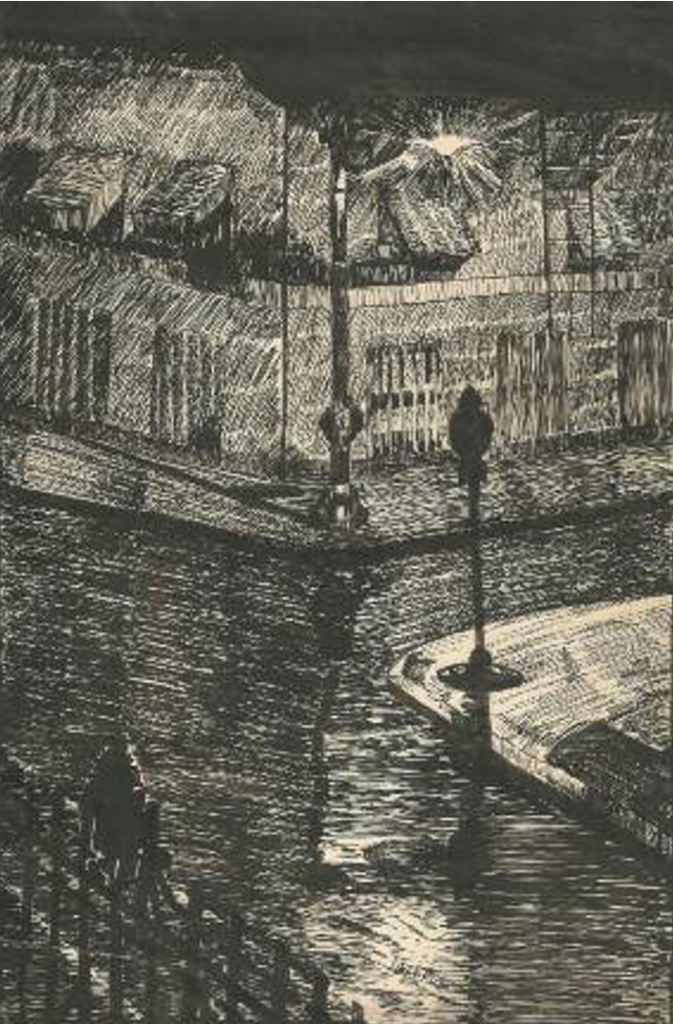The year was 1931 when gallerist Julien Levy opened his gallery of Surrealist paintings, drawings, sculpture, and fine art photography. Levy’s landmark exhibition of surrealism would come in 1932. Artists Eugène Berman, Jean Cocteau, Marcel Duchamp, Max Ernst, Arshile Gorky, Man Ray, and Salvador Dali were among those exhibited. It was an exhibition in November of 1932, alongside Etchings by Pablo Picasso and Objects by Joseph Cornell, that an unrecorded exhibition by a 20-year-old New York artist, Sidney Lazarus, titled Drawings by Sidney Lazarus took place.

Rainy Streets, Sidney Lazarus 1929
Scroll forward to today, and it is Sidney Lazarus’ works that are being highlighted in the current exhibition at Shepherd W & K Galleries in New York. As Shephard gallerists Robert Kashey and David Wojciechowski put together the exhibit celebrating Marie Difilippantonio and Beth Warren Gate’s four-volume publication of Julien Levy: The Man, His Gallery, His Legacy, it was the mystery of artist Sidney Lazarus, his artwork, and the little known 1932 exhibition that captured their attention. It was only in 2015 that evidence of Lazarus’ 1932 exhibition alongside Picasso and Cornell was uncovered and is now the subject of a chapter in the Julien Levy book.
Bronx-born artist Sidney Lazarus (1912-1973) was an insider at the very heart of the 1930’s avant-garde. With a boundless imagination, Sidney Lazarus’ obscurity in the art world is only understandable by examining his viewpoint and motivations. The inspiration for his art came from his high regard for the “impromptu impulse.” All impulses were viewed by him as creative directives, no matter how playful or serious, mischievous, or dark. Such irreverent spontaneity gave shape to both his daily life and his art. One day he would do a meticulous drawing of a doorknob, the next it was some hauntingly surreal image of demons.

Dream, Sidney Lazarus 1929
In 1932, at the age of 20, he became the youngest contributor to Alexander King’s Americana magazine, a short-lived satiric publication that had as contributors: George Grosz, John Sloan, S.J. Perlman, William Steig, Peggy Bacon, ee Cummings, Al Hirschfeld and Miguel Covarrubias. He did numerous drawings for the magazine and became a lifelong friend of King and Hirschfeld. That same year, Charlot arranged for a one-man exhibition of Lazarus’ drawings at the Julien Levy Gallery.
In 1935, Lazarus was appointed by the College Art Association as an art supervisor for three grade schools in Far Rockaway, as part of the WPA’s mandate to employ artists. In 1942, The Metropolitan Museum employed him to do decorative maps, chalk talks, and demonstrations in its Junior Museum. When the Depression ended, Lazarus was approached to enter a joint business venture drawing comics. For the next ten years, he drew comic book art for DC, Dell, Parents Institute, and Quality Comics, which made it possible for him to earn a living working part time and still be able to find time to paint and draw. During this period, he also illustrated books for Charles Scribner & Sons, Harper & Brothers, Julien Messner, and Whitman Brothers, as well as drawing for the PM newspaper.
In the 1940s, America’s art world was dominated by Social Realism and Regionalism. Lazarus didn’t commit himself to either of those movements, but they appealed to him. Of all the modern art movements, he identified most with Surrealism and Dadaism. As Abstract Expressionism came to define New York’s art world, Lazarus pulled back from the gallery scene as he was much more interested in the role of Surrealism and DaDa in art.

The Dying Man, Sidney Lazarus 1953
In the late 1950s, Lazarus was in New York earning a living doing line drawings of TV stars for ABC, CBS, and NBC. His drawings were supplied for publication to newspaper editors across the country by these major networks to promote their new television shows. As a counterpoint to commercial assignments that kept his family financially afloat, Lazarus felt the need to connect to the world in the role of an artist/philosopher. The impetus that led him to urge friends to explore their creativity, now broadened into a full-fledged philosophy based on insights from his study of Buddhism. He felt that he was onto something unique in proposing that people formed reality through the power of their own beliefs.

Creature, Sidney Lazarus 1957
His son, Douglas Lazarus recalls, “Interestingly, he rarely did preliminary sketches or designs for a painting or drawing. He just let them unfold, and very often started a picture in one corner. The image flowed outward until it had filled the entire page with perfect form and balance. He apparently had a strong sense of what he wanted each complete picture to look like, envisioning the whole and holding all its elements in his mind. He referred to his art as ‘hand fruit’ since he felt that he could simply reach up and pluck pictures out of the air.”
Lazarus was considered singularly eccentric by contemporaries for his idiosyncratic views, but generally acknowledged for his powerful imagination, highly skilled talents, and the mystical undertones within his work. He admired and identified with outsider artists like William Blake and Henri Rousseau, obscure in their lives, opposing the ruling artistic attitude of their periods.

Elephant Tapestry, Sidney Lazarus 1965
Douglas Lazarus shared: “His ultimate dream was to live in a world where his artistic talent did not set him apart but gave him commonality with a human race all working to its full creative potential. ‘How would you define a person that is not creative?’ I once asked him. ‘They have abdicated,’ he replied.”
________________________________
For more information about the Shepherd W & K Galleries, go to https://shepherdgallery.com/
The Julien Levy, The Man, His Gallery, His Legacy exhibit, featuring works by Sidney Lazarus with other artists championed by Julien Levy, may be viewed at the Shepherd W & K Galleries through March 29, 2024.
To see the full catalog for the Julien Levy, The Man, His Gallery, His Legacy Exhibit, go to: https://shepherdgallery.com/wp-content/uploads/2024/01/julien-levy-the-man-his-gallery-his-legacy.pdf






NO COMMENT